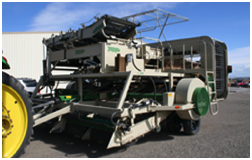 If you’re not an engineer or farmer or agronomist, an onion harvester looks like a bunch of random bits of metal slapped together—knobby, angular, lots of sharp edges, vaguely resembling the Apollo moon lander. Or, on second glance, a rocket launcher. The machine pictured at left is made in Parma, Idaho by Top Air. It’s hard for the uneducated, like me, to see how the thing works without bursting apart the moment someone flips a switch. But one aficionado wrote on a farming blog that when an onion harvester is going full tilt, it’s “a good-looking machine. A work of art.” The sorting cage spins like the fan on a jet boat, pulleys, hydraulics and conveyor belts humming and pumping, shedding dirt, root stems, and onion skin in a fine spray from the rear. During the October harvest, I watched one in a field outside Ontario, Oregon. A green John Deere tractor straddled a long row of onions as it pulled the harvester at a crawl, so the machine could scoop the onions already been cut from their roots by an onion digger—that’s a whole different machine—into that whirling cage that shook the onions out, and pulled them back inside on a conveyor belt that carried them up and out the top to be dumped in a truck driven alongside. Maybe “dumped” isn’t the right word. It was more like they were slowly laid into the truck bed, lest they be spoiled. The thing about onions is they’re delicate, easily bruised, unlike potatoes that machines can dig and cut and summarily drop into trucks. But an onion is smoother and softer, a thing to be handled gently so that it lands nicely when it rolls down that conveyor to the truck. “An onion’s gotta look pretty,” a farmer told me, “nice and shiny.”
If you’re not an engineer or farmer or agronomist, an onion harvester looks like a bunch of random bits of metal slapped together—knobby, angular, lots of sharp edges, vaguely resembling the Apollo moon lander. Or, on second glance, a rocket launcher. The machine pictured at left is made in Parma, Idaho by Top Air. It’s hard for the uneducated, like me, to see how the thing works without bursting apart the moment someone flips a switch. But one aficionado wrote on a farming blog that when an onion harvester is going full tilt, it’s “a good-looking machine. A work of art.” The sorting cage spins like the fan on a jet boat, pulleys, hydraulics and conveyor belts humming and pumping, shedding dirt, root stems, and onion skin in a fine spray from the rear. During the October harvest, I watched one in a field outside Ontario, Oregon. A green John Deere tractor straddled a long row of onions as it pulled the harvester at a crawl, so the machine could scoop the onions already been cut from their roots by an onion digger—that’s a whole different machine—into that whirling cage that shook the onions out, and pulled them back inside on a conveyor belt that carried them up and out the top to be dumped in a truck driven alongside. Maybe “dumped” isn’t the right word. It was more like they were slowly laid into the truck bed, lest they be spoiled. The thing about onions is they’re delicate, easily bruised, unlike potatoes that machines can dig and cut and summarily drop into trucks. But an onion is smoother and softer, a thing to be handled gently so that it lands nicely when it rolls down that conveyor to the truck. “An onion’s gotta look pretty,” a farmer told me, “nice and shiny.”